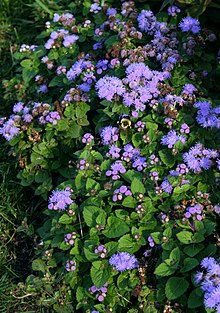Ageratum houstonianum
| Ageratum houstonianum | |
|---|---|

| |
| Scientific classification | |
| Kingdom: | Plantae |
| Clade: | Tracheophytes |
| Clade: | Angiosperms |
| Clade: | Eudicots |
| Clade: | Asterids |
| Order: | Asterales |
| Family: | Asteraceae |
| Genus: | Ageratum |
| Species: | A. houstonianum
|
| Binomial name | |
| Ageratum houstonianum | |
| Synonyms[1] | |
|
Synonymy
| |
Ageratum houstonianum, commonly known as flossflower, bluemink, goatweed, blueweed, pussy foot or Mexican paintbrush, is a cool-season annual plant[2][3] often grown as bedding in gardens.[4]
Description
[edit]This herbaceous annual or dwarf shrub grows to 0.3–1 m (1 ft 0 in – 3 ft 3 in) high, with ovate to triangular leaves 2–7 cm (0.79–2.76 in) long, and blue flowerheads (sometimes white, pink, or purple). The flower heads are borne in dense corymbs. The ray flowers are threadlike and fluff-haired, leading to the common name. The narrow lanceolate bracts are pointed, denticulate only at the top and glandular hairy. The flowering period is from May to November in the northern hemisphere.[5] The plant attracts butterflies.[6]

Range
[edit]The plant is native to Central America in Guatemala and Belize, and adjacent parts of Mexico, but has become an invasive weed in other areas. It was also naturalized in large parts of the tropics and in the southern United States. Its habitat is pastures, moist forest clearings and bushes up to altitudes of 1,000 metres (3,300 ft).
Today, it is widely used as an ornamental plant for summer borders and balcony boxes, high varieties also as cut flowers. The species is cultivated once a year, having numerous varieties whose crowns may be dark blue, purple, pink and white. Preferring cool soils and exposure in full sun, high varieties reach stature heights up to 60 centimetres (24 in).[7][8]
Chemistry
[edit]Ageratum has evolved a unique method of protecting itself from insects: it produces a methoprene-like compound which interferes with the normal function of the corpus allatum, the organ responsible for secreting juvenile hormone during insect growth and development. This chemical triggers the next molting cycle to prematurely develop adult structures, and can render most insects sterile if ingested in large enough quantities. [9]
Toxicity
[edit]Ageratum houstonianum is toxic to grazing animals, causing liver lesions.[10][11] It contains pyrrolizidine alkaloids.[12]
Weed risk
[edit]Ageratum houstonianum is prone to becoming a rampant environmental weed when grown outside of its natural range. It has become an invasive weed in the United States, Australia, Europe, Africa, China, Japan, New Zealand, and the Philippines.[13]
Varieties
[edit]
- Ageratum houstonianum var. angustatum B.L. Rob.[14]
- Ageratum houstonianum f. isochroum
- Ageratum houstonianum f. luteum
- Ageratum houstonianum var. muticescens
- Ageratum houstonianum f. niveum
- Ageratum houstonianum f. normale
- Ageratum houstonianum var. typicum
- Ageratum houstonianum f. versicolor
The cultivars 'Blue Danube'[15] and 'Blue Horizon'[16] have gained the Royal Horticultural Society's Award of Garden Merit.[17]
References
[edit]- ^ "Ageratum houstonianum Mill.". The Global Compositae Checklist (GCC) – via The Plant List. Note that this website has been superseded by World Flora Online
- ^ "Ageratum houstonianum (Ageratum, Blue Billygoatweed, Bluemink, Floss Flower, Mexican Ageratum)". North Carolina Extension Gardener Plant Toolbox. NC State Ag Extension. Retrieved 2021-05-15.
- ^ "Ageratum houstonianum". Plant Finder. Missouri Botanical Garden. Retrieved 2021-05-15.
- ^ Eckehart J. Jäger, Friedrich Ebel, Peter Hanelt, Gerd K. Müller (ed.): Rothmaler - excursion flora of Germany. Volume 5: Herbaceous ornamental and useful plants . Spektrum Akademischer Verlag, Berlin Heidelberg 2008, ISBN 978-3-8274-0918-8 , p. 553 .
- ^ New South Wales Flora Online, Ageratum houstonianum
- ^ "Ageratum houstonianum - Plant Finder". www.missouribotanicalgarden.org. Retrieved 2021-12-20.
- ^ Nesom, Guy L. (2006). "Ageratum houstonianum". In Flora of North America Editorial Committee (ed.). Flora of North America North of Mexico (FNA). Vol. 21. New York and Oxford: Oxford University Press – via eFloras.org, Missouri Botanical Garden, St. Louis, MO & Harvard University Herbaria, Cambridge, MA.
- ^ Species profile
- ^ I. Kiss; et al. (September 1988), "Biological activity of precocene analogues on Locusta migratoria", Cellular and Molecular Life Sciences, 44 (9): 790–792, doi:10.1007/BF01959168, S2CID 38482650
- ^ Acamovic, T., Stewart, C.S., Pennycott, T.W.,"Poisonous Plants and Related Toxins", 2004
- ^ Noa, M., Sanchez, L.M., Durand, R., "Ageratum houstonianum toxicosis in Zebu cattle", Veterinary and human toxicology, 2004, vol.46, no4, pp.193-195.
- ^ Wiedenfeld H, Andrade-Cetto A., "Pyrrolizidine alkaloids from Ageratum houstonianum Mill.", Phytochemistry, 2001 Aug, pp1269-71 [1]
- ^ Global Compendium of Weeds, Ageratum houstonianum (Asteraceae)
- ^ JSTOR Plant Science
- ^ "Ageratum houstoninum 'Blue Danube'". RHS. Retrieved 27 February 2020.
- ^ "Ageratum houstonianum 'Blue Horizon'". RHS. Retrieved 27 February 2020.
- ^ "AGM Plants - Ornamental" (PDF). www.rhs.org. Royal Horticultural Society. November 2018. p. 3. Retrieved 27 February 2020.
External links
[edit] Media related to Ageratum houstonianum at Wikimedia Commons
Media related to Ageratum houstonianum at Wikimedia Commons- Bailey, L. H. (2005). Manual of Gardening (Second Edition). Project Gutenberg Literary Archive Foundation.
